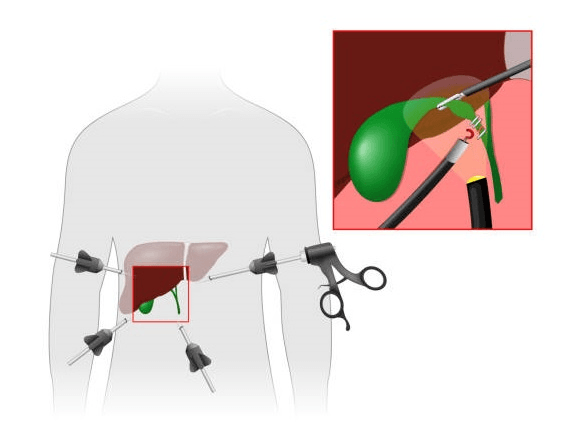Cholecystectomy
The gallbladder is a small pear-shaped storage organ located under the liver on the right side of the abdomen. It stores bile (yellowish-brown fluid) produced by the liver, which is required to digest fat. As food enters the small intestine, cholecystokinin (a hormone) is released, which signals the contraction of the gallbladder to release bile into the small intestine through the common bile duct (a small tube connecting liver and intestine).
Although the gallbladder helps in digestion, it is not an essential part of the body as bile can reach the small intestine in many other ways. Therefore, gallbladder removal (Cholecystectomy) is a safe treatment for gallbladder problems.
Major gallbladder diseases include gallstones (concentrated bile) that can block the ducts (biliary colic), and cholecystitis (inflammation of the gallbladder). The removal of the gallbladder is performed by a procedure called Cholecystectomy and is the most effective way to treat gallstones or other gallbladder diseases.
Procedure
Surgical removal of the gallbladder can be done one of two ways:
Open Cholecystectomy
Open method involves a 5-7 inch incision in the upper right-hand side of the abdomen, below the ribs. Your surgeon removes the gallbladder through the large, open incision.
Laparoscopic Cholecystectomy
Laparoscopic Cholecystectomy is a less invasive surgical method that uses a device called a laparoscope. The laparoscope is a small, thin tube with a light and tiny video camera (connected to a television monitor) attached at the end, which helps visualize inside the abdomen during the operation.
The surgery is performed under general anaesthesia. Your surgeon makes 3-4 small incisions in the abdomen. The laparoscope is inserted into the body through one of the incisions. The television monitor will guide the surgeon to insert other surgical instruments through the other incisions. Carbon dioxide is injected into the abdomen to inflate the abdominal cavity so that the gallbladder and other adjacent organs can be visualized easily. Your surgeon first clips and divides the cystic duct and blood vessels leading to the gallbladder, and then removes the gallbladder. The gallbladder is then sent to pathology for microscopic examination.
Your surgeon may also perform a procedure called a cholangiogram during the surgery, which uses X-rays and a dye injected into the body to view the bile ducts. This is done to identify gallstones that could have been missed, obstructions or narrowing of the bile ducts. If stones are present, the surgeon uses a special instrument and removes them.
The gas is then deflated from the abdominal cavity, local anaesthetic applied and wounds closed with absorbable sutures. Waterproof dressings are then applied.
Post-operative care
Due to the less invasive laparoscopic technique, recovery is swift and usually, the patient can go home usually the day after surgery.
The incisions heal quickly with less pain and scarring than traditional methods of surgery. You can expect to be back to work within a week in most instances.
Practical recovery notes include:
Hospital Stay - Most people go home the morning after surgery. It is recommended that you be accompanied home by a carer who will stay with you (or very close by) for the first 24 hours.
Wound Care - Your wounds are closed with dissolvable sutures and covered with waterproof dressings. You can shower normally. Remove your dressings in 5 days - your wounds should be healed by then and you do not need further dressings.
Diet - There are no restrictions on your diet. However, some people can develop loose stools in the first few weeks after gallbladder removal.
If you are experiencing loose stools, try to
- Avoid greasy or fried foods
- Add soluble fibre to your diets, such as bran, nuts, seeds, lentils and peas
- Eat smaller, more frequent meals
- Limit foods that worsen diarrhoea such as caffeine, dairy and sweet foods
Driving - You should not drive for at least 24 hours after general anaesthesia. You can start driving as soon as you can safely control the vehicle, usually after a few days.
Physical Activity - You are encouraged to do as much walking as is comfortable. Limit your activities to light duties (no lifting over 5 kg) for at least 3 to 4 weeks, or until you are comfortable.
Risks and Complications
The removal of the gallbladder is generally a safe procedure, but like all operations, there are risks and complications associated with the procedure.
Some of these include;
- Reactions to general anaesthesia
- Bleeding
- Infection
- Injury to the bile duct / bile leak
- Retained gallstones
- Need for second procedure
- Damage to surrounding organs
Advantages
The advantages of laparoscopic Cholecystectomy when compared to open surgical technique include shorter hospital stay, smaller incisions, less post-operative pain and faster recovery.

